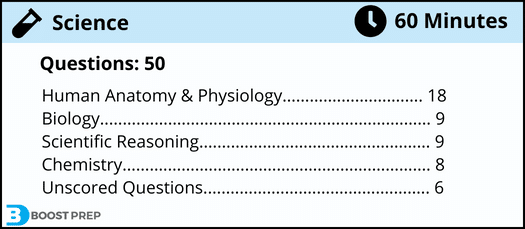Take our TEAS science practice test below to see how you do.
Our exam is 100% free and includes answer explanations, similar questions to the actual exam, and no registration required. If you are looking for another subject, visit our TEAS online practice page.
Free TEAS Science Practice Test
Exam Summary
0 of 20 Questions completed
Questions:
Information
You have already completed the exam before. Hence you can not start it again.
Exam is loading…
You must sign in or sign up to start the exam.
You must first complete the following:
Results
Results
Time has elapsed
You have reached 0 of 0 point(s), (0)
Earned Point(s): 0 of 0, (0)
0 Essay(s) Pending (Possible Point(s): 0)
Categories
- Not categorized 0%
-
Keep Studying: You will not pass the TEAS science section right now. You should continue to brush up on science subjects. Take some of our full-length practice exams.
-
Almost There: You may be able to pass the TEAS science section right now, but it will be close. Take some of our full-length practice exams.
-
You Are Ready: We feel you are ready for the TEAS science section. You can continue to study if you would like to be safe. Take some of our full-length practice exams.
- 1
- 2
- 3
- 4
- 5
- 6
- 7
- 8
- 9
- 10
- 11
- 12
- 13
- 14
- 15
- 16
- 17
- 18
- 19
- 20
- Current
- Review
- Answered
- Correct
- Incorrect
-
Question 1 of 20
1. Question
CorrectIncorrect -
Question 2 of 20
2. Question
CorrectIncorrect -
Question 3 of 20
3. Question
CorrectIncorrect -
Question 4 of 20
4. Question
CorrectIncorrect -
Question 5 of 20
5. Question
CorrectIncorrect -
Question 6 of 20
6. Question
CorrectIncorrect -
Question 7 of 20
7. Question
CorrectIncorrect -
Question 8 of 20
8. Question
CorrectIncorrect -
Question 9 of 20
9. Question
CorrectIncorrect -
Question 10 of 20
10. Question
CorrectIncorrect -
Question 11 of 20
11. Question
CorrectIncorrect -
Question 12 of 20
12. Question
CorrectIncorrect -
Question 13 of 20
13. Question
CorrectIncorrect -
Question 14 of 20
14. Question
CorrectIncorrect -
Question 15 of 20
15. Question
CorrectIncorrect -
Question 16 of 20
16. Question
CorrectIncorrect -
Question 17 of 20
17. Question
CorrectIncorrect -
Question 18 of 20
18. Question
CorrectIncorrect -
Question 19 of 20
19. Question
CorrectIncorrect -
Question 20 of 20
20. Question
CorrectIncorrect
Test Your Knowledge (All Subjects)
Curious if you are actually prepared for the exam? You can take our full diagnostic exam (100% free) and instantly find out if you are ready for the exam.
TEAS Science Exam Overview
TEAS Science is 1 of 4 sections given during the TEAS exam. When taking this section, you will find the following:
- 50 Questions
- 60 Minutes
The 50 TEAS science questions are split into the following 4 categories:
- Human Anatomy and Physiology: 18 Questions
- Biology: 9 Questions
- Scientific Reasoning: 9 Questions
- Chemistry: 9 Questions
- Unscored Questions: 6 Questions
If you want to take a break from science and focus on another section, you can visit our free TEAS practice exams home.
Studying for TEAS Science
As mentioned above, there are 4 different categories on this section. Within each of those categories, there are specific concepts and topics tested. You will want to make sure you are familiar with the following:
- Anatomy and Physiology
- Cells, tissues, and organs
- The systems of the body
- Non-infectious diseases
- Biology
- Cellular Biology
- Mitosis and Meiosis
- DNA and Chromosomes
- Genetics & Inheritance
- Chemistry
- States of matter
- Bonds
- Periodic table
- Reaction types
- Scientific Method
- Relationships & tools
- Reasoning & logic
- Experimental Design & Analysis
If some of those topics need to be brushed up on, you can use our TEAS test study guide to prepare. We cover everything you need to know in that.
TEAS Science FAQs
There are 50 total questions on TEAS science. There will be 6 unscored questions (as part of the 50). You will not know which questions are unscored.
You will have 60 minutes to complete the science portion of the exam. To keep pace, you will want to spend less than 72 seconds per question.
The best way to pass the TEAS science section is to take a TEAS science practice test. A practice test gives you insight into what the actual test will look and feel like.
By going through multiple TEAS science questions you are allowing your brain to get a feel for how it paces through the test. By doing so, you are training your brain to work when under pressure, so it will be ready when test day comes.
Lastly, train your brain in increments, rather than cramming information into it. Take one practice test and review what you answered wrong and then give your brain a rest.
The science section is one of the most difficult sections on the exam. It covers a lot of concepts and topics.
In addition to the amount of content you will be required to know, there is also a time constraint. You will need to spend less than 72 seconds per question to ensure you finish with enough time.
A good TEAS score on the science section is somewhere in the range of 78% to 90%, or a 35-40 out of 44. An exemplary score is 90.7%-100% or a 41 or above.
Read more on TEAS scores in our complete guide.



